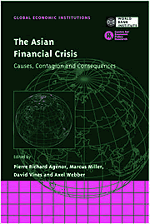Book contents
- Frontmatter
- Contents
- List of figures
- List of tables
- Preface
- List of conference participants
- Acknowledgements
- List of abbreviations and acronyms
- Introduction
- Part One General Accounts
- Part Two Theoretical Contributions
- 5 Capital markets and the instability of open economies
- Discussion
- 6 Volatility and the welfare costs of financial market integration
- Discussion
- 7 A theory of the onset of currency attacks
- Discussion
- Part Three Contagion
- Part Four Policy Responses
- Index
6 - Volatility and the welfare costs of financial market integration
from Part Two - Theoretical Contributions
Published online by Cambridge University Press: 26 February 2010
- Frontmatter
- Contents
- List of figures
- List of tables
- Preface
- List of conference participants
- Acknowledgements
- List of abbreviations and acronyms
- Introduction
- Part One General Accounts
- Part Two Theoretical Contributions
- 5 Capital markets and the instability of open economies
- Discussion
- 6 Volatility and the welfare costs of financial market integration
- Discussion
- 7 A theory of the onset of currency attacks
- Discussion
- Part Three Contagion
- Part Four Policy Responses
- Index
Summary
Introduction
The view that international financial market integration brings significant long-term benefits is hardly a controversial one among mainstream economists. Financial openness, for instance, increases opportunities for portfolio risk diversification and consumption smoothing through borrowing and lending; and producers who are able to diversify risks on world capital markets may invest in more risky (and higher-yield) projects, thereby raising the country's rate of economic growth (Obstfeld, 1994, 1998). Increased access to the domestic financial system by foreign banks is often viewed as raising the efficiency of the intermediation process between savers and borrowers, thereby lowering the cost of investment. Higher foreign direct investment flows (FDI) often have a direct, positive effect on productivity and the efficiency of domestic resource utilisation (through transfers of technology and other intangible assets), thereby raising the rate of economic growth.
But it is increasingly recognised that a high degree of financial openness may entail significant short-term costs as well. The magnitude of the capital flows recorded by some developing countries in recent years, and the abrupt reversals that such flows have displayed at times, have raised serious concerns among policy makers. The Mexican peso crisis of December 1994 led to financial instability throughout Latin America, particularly in Argentina. The collapse of the pegged exchange rate regime in Thailand on 2 July 1997 led to currency turmoil throughout Asia, particularly in Indonesia, Korea, Malaysia and the Philippines.
- Type
- Chapter
- Information
- The Asian Financial CrisisCauses, Contagion and Consequences, pp. 195 - 225Publisher: Cambridge University PressPrint publication year: 1999
- 1
- Cited by



